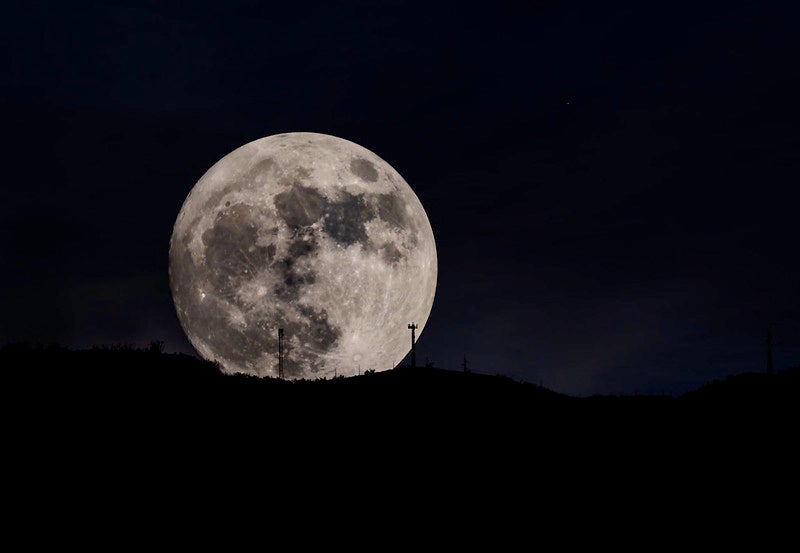
Friday, September 29
The end of the month brings us the September Full Moon, also known as the Harvest Moon. Full Moon officially occurs at 5:58 A.M. EDT today; this is also the last Super Moon of the year, as our satellite recently reached perigee, the closest point to Earth in its orbit. There have been several Super Moons this year, but now the orbital period and lunar phase are falling out of sync and the next Full Moon will occur long enough after perigee that it won’t be considered “Super.”
Although this isn’t the largest or brightest Super Moon of the year, our satellite’s light will still dominate the sky from dusk until dawn. Deep-sky observing is challenging during the Full Moon, so let the Moon steal the show and take some time to observe the lunar surface with the naked eye, binoculars, or a telescope. Note that the Full Moon can be quite bright through optics; you can use a Moon filter, cover up some of your telescope’s aperture, or even slip on a pair of sunglasses for more comfortable viewing!
This is also a great time to try photographing the Moon in the sky, as its bright light will illuminate earthly landscapes and set up some great shots.
Sunrise: 6:54 A.M.
Sunset: 6:46 P.M.
Moonrise: 7:06 P.M.
Moonset: 7:01 A.M.
Moon Phase: Full
*Times for sunrise, sunset, moonrise, and moonset are given in local time from 40° N 90° W. The Moon’s illumination is given at 12 P.M. local time from the same location.
Saturday, September 30
With a bright Moon still in the sky, we’re limited when it comes to observing targets — but there are still plenty. Let’s look tonight for Kemble’s Cascade, a famous asterism (or unofficial pattern of stars) that swings around the North Star as part of the circumpolar constellation Camelopardalis.
Wait several hours after sunset, allowing Camelopardalis and its stars to begin swinging upward in the sky to the east of the North Star and its constellation, Ursa Minor. The Little Dipper should appear upside-down, the open portion of its bowl or cup pointed toward the ground. By about 10:45 P.M. local daylight time, Kemble’s Cascade is 35° high. To find the asterism, start at Polaris and slide southwest. Magnitude 4.3 Alpha (α) Camelopardalis lies about 23° south-southwest of the North Star. From Alpha, it’s about 6.5° west-southwest to land on Kemble’s Cascade.
Through binoculars or a small scope, you’ll see about 16 stars between 7th and 9th magnitude stretching in a 2.5°-long chain that runs northwest to southeast. You may also note a brighter 5th-magnitude star about midway down the chain. These stars all appear to “cascade” downward like a stream or waterfall, ending in a spray of stars that marks the 6th-magnitude open cluster NGC 1502.
Sunrise: 6:55 A.M.
Sunset: 6:44 P.M.
Moonrise: 7:32 P.M.
Moonset: 8:17 A.M.
Moon Phase: Waning gibbous (98%)
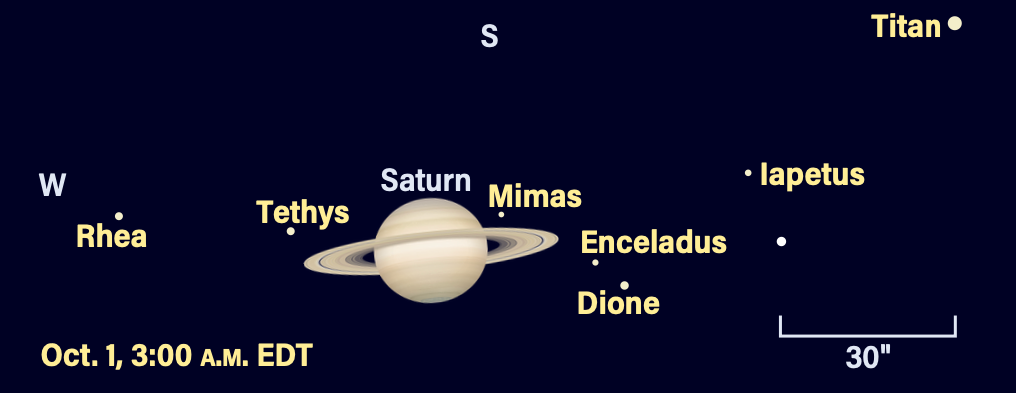
Sunday, October 1
Let’s open October with the solar system’s most stunning planet, Saturn. Early this morning, the ringed planet sits just 1′ west of a 10th-magnitude field star, putting the star as close to the planet as many of its moons. While magnitude 8.5 Titan lies about 1.5′ to Saturn’s southeast, 11th-magnitude Iapetus appears closer to the planet, on its way to its eastern elongation. This morning, Iapetus — normally hard to spot — sits just 15″from that field star, offering an easy way to nab it.
Several other moons cluster nearby, including 10th-magnitude Dione, Rhea, and Tethys. Mimas, at 13th magnitude, is incredibly difficult, but at 3 A.M. EDT lies just southeast of the planet’s disk, ready to begin a transit around 3:45 A.M. EDT, followed closely by its shadow across Saturn’s southern regions. See if you can capture the event with high-speed video to catch brief moments of good seeing throughout the nearly two-hour-long transit.
Asteroid 2 Pallas is in conjunction with the Sun at noon EDT today, rendering it invisible.
Late this evening, the Moon passes 3° north of Jupiter at 11 P.M. EDT as they are rising in the east amid the faint stars of Aries. The giant planet is flanked on both sides by its Galilean moons: Europa (farthest) and Io to the east, and Callisto (farthest) and Ganymede to the west. Follow the planet overnight and into the early-morning sky of the 2nd to observe the Great Red Spot crossing the center of the disk around 4 A.M. EDT.
Sunrise: 6:56 A.M.
Sunset: 6:42 P.M.
Moonrise: 8:01 P.M.
Moonset: 9:32 A.M.
Moon Phase: Waning gibbous (93%)
Monday, October 2
Asteroid 29 Amphitrite reaches opposition at 3 A.M. EDT this morning. The main-belt world lies in the constellation Pisces, about 6° west of 4th-magnitude Delta (δ) Piscium. At 9th magnitude, a pair of binoculars or any size telescope should pick up this spot of light.
In the afternoon, the wanning gibbous Moon passes 3° north of Uranus at 1 P.M. EDT. By the time they rise late this evening, the Moon has continued east and sits nearly 8° from the planet. Our satellite now hangs just south of the stunning Pleiades cluster (M45) in Taurus, less than 2° from Eta (η) Tauri, also named Alcyone. This is a bright, young B-type star some 6 times as massive and 10 times as large as our Sun. It also rotates 100 times more rapidly than our star, spinning so quickly that it flings some of its own gas outward to form an emission nebula around it.
Many naked-eye observers note the Pleiades looks a bit like a tinier version of the Little Dipper. With the Moonlight washing out the fainter background stars, can you see it? Alcyone sits where the handle, composed of Atlas and Pleione, meet the “dipper’s” cup, which also contains Maia, Merope, and Electra.
Sunrise: 6:57 A.M.
Sunset: 6:41 P.M.
Moonrise: 8:33 P.M.
Moonset: 10:46 A.M.
Moon Phase: Waning gibbous (86%)
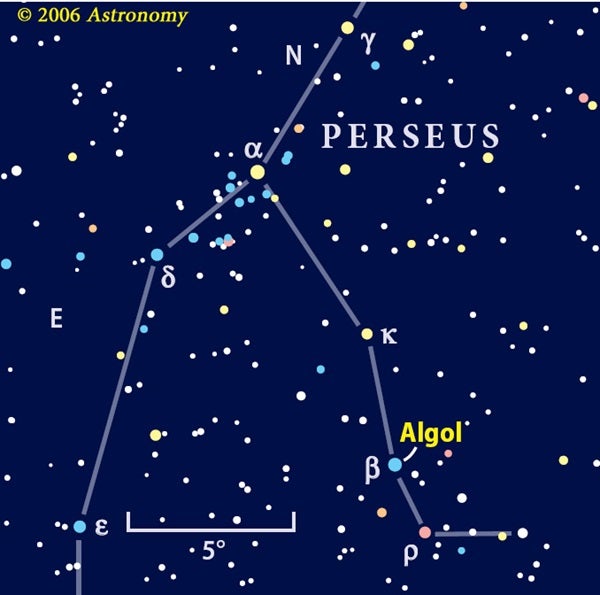
Tuesday, October 3
The variable star Algol in Perseus is approaching its minimum magnitude, which occurs at 6 A.M. EST tomorrow morning. Check it out tonight in the east around 10 P.M. local daylight time, when it’s 30° high and climbing. It lies some 25° above the Moon’s position (with our satellite near the horizon) at that time.
Algol is also sometimes called the Demon Star because it changes brightness quite noticeably, even to the naked eye. Over the course of 2.87 days, it loses or gains roughly a magnitude because it is part of an eclipsing binary system in which its companion passes in front of Algol from our point of view, markedly dimming the star as it does so. Algol’s magnitude ranges from 2.1 at its brightest to 3.4 at its dimmest.
The easiest way to watch this happen for yourself is to compare Algol to two nearby stars: When it is uneclipsed, Algol matches the magnitude of Gamma (γ) Andromedae, 12° to its west. But near its minimum, as it is now, you’ll note that it shines with a brightness similar to 3rd-magnitude Epsilon (ε) Persei 9.5° to its east. Take a look at this region and see which star you think Algol better mirrors — then come back tomorrow and make the same comparison again!
Sunrise: 6:58 A.M.
Sunset: 6:39 P.M.
Moonrise: 9:13 P.M.
Moonset: 11:59 A.M.
Moon Phase: Waning gibbous (78%)
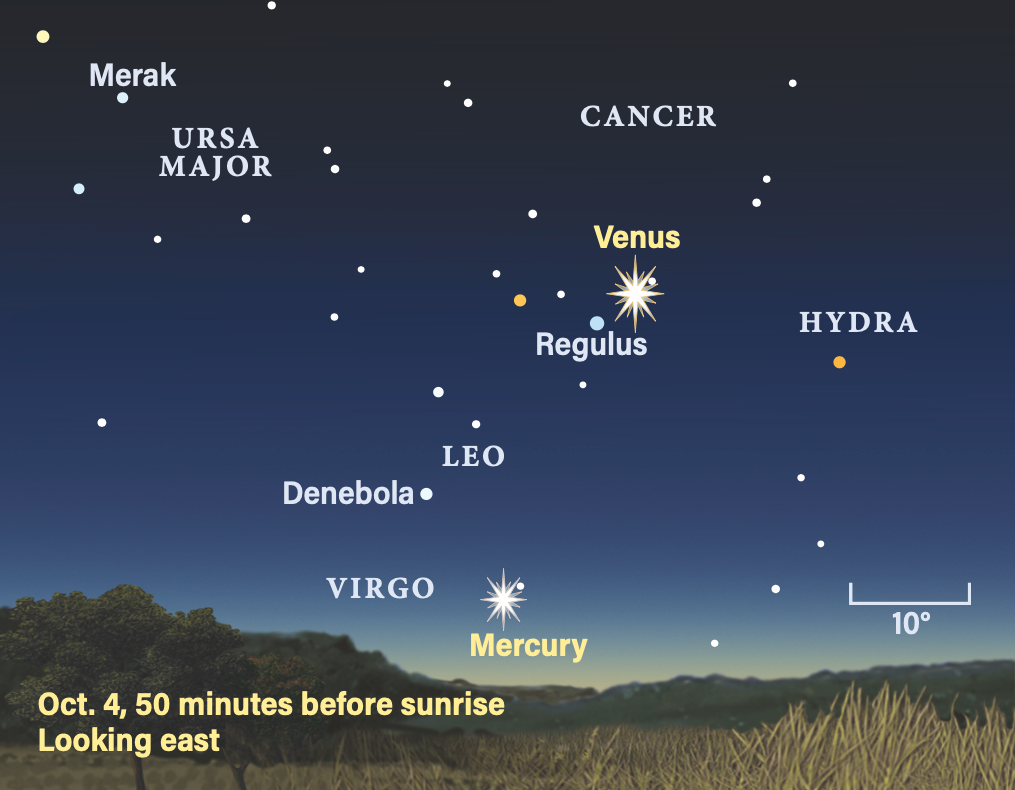
Wednesday, October 4
Catch Mercury during its brief morning appearance this month before it sinks too close to the Sun for observation. It’s heading for conjunction with the Sun on the 20th, after which it will slowly move into the evening sky and begin to appear after sunset in late November.
You’ll find the innermost planet in the predawn sky, just 2° high 50 minutes before sunrise. Twenty minutes later, it’s risen to about 5° above the eastern horizon and shines at magnitude –1.2. The planet lies in far western Virgo, some 33° east of magnitude –4.7 Venus in Leo, which is closing in on the bright star Regulus and will pass close to it next week (we’ll check back in then).
Compare the two planets through a telescope and you’ll find Mercury appears much smaller (5″ across, compared with Venus’ 30″-wide span) but is more fully lit. Mercury appears as an 89-percent-lit gibbous, but Venus is a 39-percent-lit crescent. The latter’s phase will continue to grow throughout the month until Venus reaches dichotomy, when it is half lit, on the 23rd.
Sunrise: 6:59 A.M.
Sunset: 6:38 P.M.
Moonrise: 9:58 P.M.
Moonset: 1:06 P.M.
Moon Phase: Waning gibbous (68%)
Thursday, October 5
Let’s revisit Jupiter in the evening sky to catch a transit of the innermost Galilean moon, Io. The event starts at 9:50 P.M. EDT, but you’ll want to get your gaze fixed on the planet well before then — provided it’s visible, as the gas giant rises around 8 P.M. local daylight time and so is below the horizon as the Io event starts for the western half of the U.S.
Those on the East Coast and some locations in the Midwest, however, will note that Ganymede is skirting the giant planet’s southern limb starting around 9:15 P.M. EDT. As Io’s shadow slips onto the disk from the east 35 minutes later, Ganymede lies roughly over the planet’s south pole as the large moon slides from east to west.
Io itself finally crosses over the cloud tops starting shortly after 10:30 P.M. EDT, when those in the Mountain time zone may start to pick up the show. The shadow continues to cross until midnight EDT, and Io takes another 41 minutes after that to finally reach the western limb and move off. By then, Io and Ganymede are both west of Jupiter, while Europa (closer) and Callisto lie far to the planet’s east.
Sunrise: 7:00 A.M.
Sunset: 6:36 P.M.
Moonrise: 10:51 P.M.
Moonset: 2:05 P.M.
Moon Phase: Waning gibbous (59%)
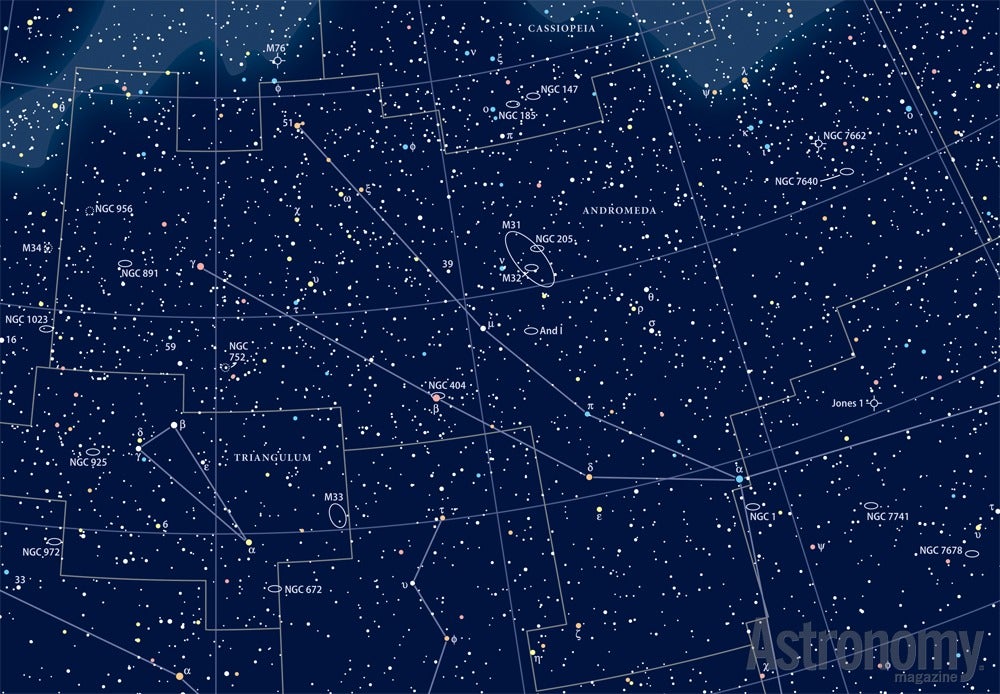
Friday, October 6
Last Quarter Moon occurs at 9:48 A.M. EDT, leaving a nice dark window between sunset and moonrise for some deep-sky observing.
Let’s go after a big, bright target: the Andromeda Galaxy (M31), a showpiece of the northern sky. For many, it is the most distant object visible to the naked eye, though you’ll need clear, dark skies and still air to see it. Averted vision works best — locate its position based on the chart above and then look slightly away from the spot it should be. A small, light-colored smudge may pop out against the background sky in the corner of your eye.
The Andromeda Galaxy sits in the constellation of the same name, northeast of the Great Square of Pegasus and northwest of Taurus and the Pleiades. More specifically, you’ll find it just 1.5° west of magnitude 4.5 Nu (ν) Andromedae.
Glowing at magnitude 3.4, Andromeda covers an impressive 3°, spreading its light out into that smudge. Through a telescope under ever-higher magnification, you’ll start to discern that the core of the galaxy, whose disk appears tilted relative to our line of sight, is brighter than the outskirts. Additionally, Andromeda is flanked by two small, 8th-magnitude companions that may be visible with your telescope: M32 just south of the galaxy’s core, and NGC 205 slightly to Andromeda’s northwest.
Sunrise: 7:01 A.M.
Sunset: 6:34 P.M.
Moonrise: 11:50 P.M.
Moonset: 2:55 P.M.
Moon Phase: Waning crescent (49%)

Sky This Week is brought to you in part by Celestron.









